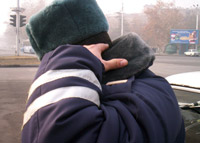After the New Year, Armenians were surprised when they came face-to-face with the transportation realities. There are no state motor vehicle inspectors on the streets for over a month now. This shouldn’t have been a surprise because it had been talked about frequently during social (even political) discussions. After coming to power, Georgian President Sahakashvili disbanded the State Motor Vehicle Inspectorate. Nowadays, that’s called wonderful PR. The West perceived this as the Georgian authorities’ willingness to take steps towards fighting against corruption. Georgians are also happy.
Patrol officers have been pick-pocketing drivers starting from the 60s and 70s and it has gotten up to the point when everyone is complaining about that. Thus, Armenians were jealous of Georgia and finally that law was passed in Armenia. As a result of legislative reforms, Armenia no longer has a State Motor Vehicle Inspectorate. Street patrol officers will substitute for that. The former State Motor Vehicle Inspectorate completed two functions: first, it completed a technical check on the car and secondly, it regulated traffic. Besides the two, the inspectors also fined the drivers. The unprecedented increase of cars and the traffic jams seen every day last year proved that the first function was fining and not traffic regulation. It has been decided that the technical checks are no longer the job of the state corps. Private, specially licensed structures will be involved in fining. It’s clear that if a non-governmental body fines the drivers, then it is not considered corruption.
There is one thing that is hard for me to understand: what difference does it make for the driver who pick-pockets the money-the government official or the individual working for the private organization? I don’t think my understanding is important. What’s important is that it is not considered corruption. After all, technical checks in Armenia are in August. Thus, that’s not important either. The important thing is that there are no longer state motor vehicle inspectors on the streets. We don’t know what the consequences will be. One of my fellow drivers told me that he liked that in the beginning. But now there is no meaning to making violations while driving if there is no inspector whom you can kid. There are some rumors that a candid camera is going to follow up on traffic instead of the police. In other words, the camera is going to do the job. It’s not clear as to who is going to pay for that equipment and how much. It is assumed that the price for the cameras and the data that they record will cost up to 20-40 million dollars. The Yerevan branch of the World Bank has already announced that the World Bank will not provide that much money to Armenia. If we consider this PR as the best imitation of the fight against corruption, then it simply won’t be the turning point. Sooner or later there will be someone to loan money for this constructive reform because the West really likes the example set by Georgia. On the other hand, we can already see the resistance from the inside. Twenty days is not enough time to come up with and analyze statistics. However, Armenian presses have already touched upon the issue, according to which, compared to last year, there have been more traffic accidents and victims. But statistics are not only based on calculations. It’s necessary to collect as much data as possible in order to make an analysis in this field, starting from weather conditions and ending with the increase of means of transportation. You get the impression that some want to make the public demand the restoration of old rules and regulations. On the other hand, it’s evident that the increase of cars has really become a pain in the head for the authorities.
During a meeting held at the Yerevan municipality, even the president of Armenia was talking about city transportation issues. It’s absurd to think about broadening the central streets what with all the rapid construction going on in the heart of Yerevan. The authorities are trying to prevent the import of old cars with the custom policy. Experts say that Armenia may turn into a cemetery of old cars, but this is not something to worry about for the time being. However, ecologists are talking about the large amount of pollution in Yerevan and that just can’t be put up with. The rise in the number of imported cars after the construction is the authorities’ most preferable topic to discuss. Those are the two fields that show the two-digit growth of Armenian economy. It seems as though the third doesn’t exist and they have been looped together to regulate transportation, starting with the promise to construct more intersections and ending with the effective traffic control. The first step-patrol officers-is not bad PR. Nearly all Armenian adults have contact with motor vehicle inspectors. However this reform, like many others, is still groundless and unorganized and is not like the reform made by Georgia. First of all, there was no propaganda for this and it is assumed that it may stop functioning after a while. Perhaps this is the reason why international organizations are thinking twice about providing loans.

